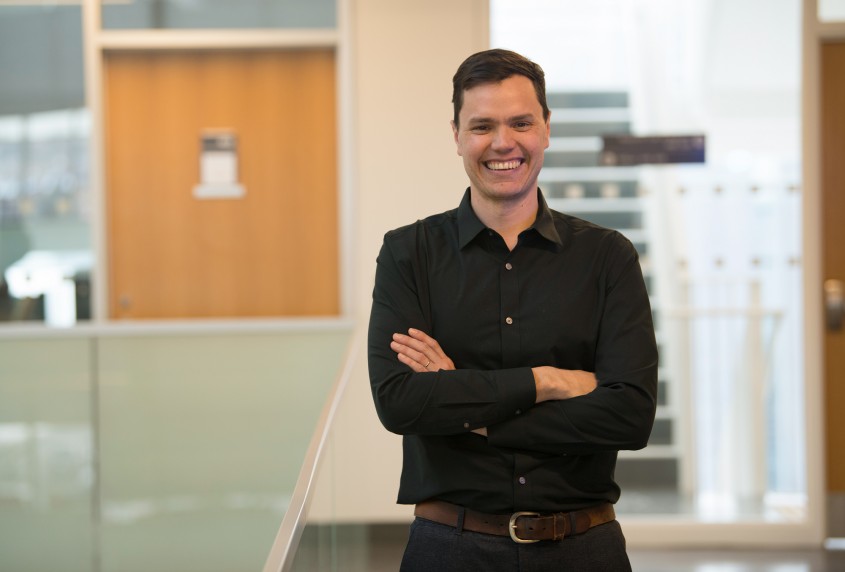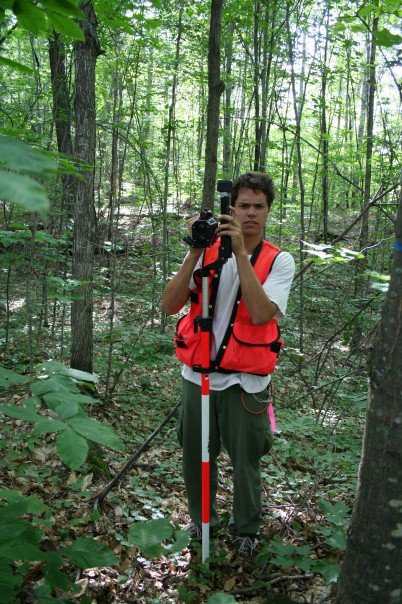Adam Martin is an Assistant Professor at the University of Toronto Scarborough in the Department of Physical and Environmental Sciences, and a PI of the Haliburton plot in Ontario, Canada. In this installment of ForestGEO’s Spotlight Series we hear from Adam about creatively navigating career choices, studying the connection between wood chemistry and ecosystem functions, and learning to drive stick shift.
When did you realize you wanted to be a scientist/work in forest ecology? How did you decide to go down this career path?
There were two significant experiences when science and forest ecology started to take shape as a possible career path for me. The first was a summer job I had during my undergraduate degree with a small, non-governmental organization in my hometown (Welland, Ontario, Canada). It was an ecosystem restoration job, primarily planting trees and removing invasive species. The science of restoration ecology was fascinating, and more importantly, simply working outside in nature was a million times better than any job I had up to that point. In the simplest terms, I started thinking that any career where I could work outside would be a good one.
The other major realization came during and right after my master’s in forest conservation at the University of Toronto. There was a 16-month period where I was incredibly fortunate to work in forests in Canada, Malaysia, Ecuador, and Dominica as a research assistant. During this time, I learned the nitty gritty of forest ecological research from some phenomenal scientists and mentors (including Sean Thomas, Nathan Kraft, Kalan Ickes, and Saara DeWalt). While my main motivation during this time was to travel and see the world’s forests, this is when I started to realize that I could shape a life and career around forest ecology and science.

What has been your biggest challenge in getting to this point in your career?
Probably the biggest challenge has been carving out career opportunities while making dedicated choices about where we choose to live. My partner’s career is in Toronto, and we loved living in the city and being close to family in Canada. So relocating after my PhD was not the ideal option. It took a fair bit of creativity (like expanding into agroecology) and passing up on some great postdocs in forest ecology, to make it happen.
When did you first get involved in the ForestGEO network?
Shortly after my master’s degree in 2006, I worked with Sean Thomas as a research assistant at the Pasoh plot in Malaysia for 3 months. Life changer. We spent days and weeks covering the whole plot, mapping termite nests. Those glimpses into the ecology of Pasoh are firmly planted in my memories: chasing gibbons, feeling the forest floor shake during a massive tree fall (from a safe distance, of course), seeing a huge troop of macaques racing through the forest in a rainstorm, working beside a hornbill. Amazing experiences that set me off on the ForestGEO path.
At that time, there were a bunch of brilliant ForestGEO scientists working in and around Pasoh, interacting and driving at impressive science. Dr. Jennifer Baltzer was running detailed experiments on tree ecophysiology, and Dr. Ken Feeley was there measuring wood density. Their research was way over my head at the time, but just their presence drove me to think harder about forest ecology. Jenn also taught me how to drive standard, in an old beater car that had a termite nest in the passenger seat. I had never worked internationally at that time, and Dr. Abdul Rahman Kassim was one of the first international scientists I met. I’m pretty certain he wouldn't have remembered me, but his knowledge of tropical forest ecology and dedication to the ForestGEO network was very impactful and inspiring.
What is the most unique or interesting aspect of your site?
The Haliburton plot is on a lake margin in central Ontario, Canada, and we access it by canoe. That must be a first for the ForestGEO network! You could walk to the plot in about 30 minutes from the closest road, but a canoe is so much more Canadian. One other unique aspect is that the forest dynamics are associated with beavers that cut down trees along the lake margins, and they have preferences for certain species. I’m guessing only the Haliburton plot would have a detectable “beaver effect.”

What questions are you currently addressing in your research/site?
I’m rather quite new as a co-PI on the Haliburton plot, having just started as an Assistant Professor in July 2019 (though I actually worked setting up the plot as a postdoc many years ago). Our first order of business was to lead a plot re-census this summer, though COVID-19 had other ideas. So we will likely be focused on that until August 2021.

Once that is in the books, I’ll turn my attention to research that explores relationships between environmental change, wood chemistry, and ecosystem functions (especially C sequestration). I’m interested in how environmental conditions determine wood chemistry, and how wood chemistry then links with processes such as above- and belowground carbon storage. I’m especially interested in pursuing detailed analyses of soil and wood carbon composition (i.e., things like lignin, cellulose, etc.). Many scientists in my home department at University of Toronto Scarborough are developing and employing remarkable new analytical chemistry techniques. In my mind, finding collaborative ways to incorporate these techniques into our understanding of ecosystem processes could make for some very interesting new additions to the ForesetGEO research program.
What is your favorite part about your work?
Fieldwork is, and always will be, my first passion. The opportunities I had to travel and work in many of the world’s forests, especially within the ForestGEO network, has been a tremendous privilege and I do not take it for granted. As my career has evolved though, carving out time for fieldwork has gotten tougher, and I find myself becoming more and more fascinated with the challenges of data analysis. I really enjoy being able to get into a “stats zone,” and think of different ways to present and visualize scientific data. Clearly, the ForestGEO network is a treasure trove for this kind of thing. I also take a lot of pleasure in working with other scientists in my department on questions related to analysis; I’ve learned amazing things from totally new areas of research like microbiology and analytical chemistry through stats.

What do you like to do when you're studying forest dynamics?
My wife and I currently have two little forest ecologists at home (1 and 3 years old), so there’s a bit of a gap between what I like to do versus what I actually do. Right now we are definitely in a “family-first” time of life. We are trying to impart a love of nature in our kids, but their love of construction equipment is clearly their first passion. So, when I’m not studying forest dynamics, I spend considerable time looking at construction sites with my kids.
When we carve out some time, we’re big on cycling. I mean cycling at a slow and steady pace on the scenic route, not in a “we’re training for the Tour de France” kind of way. We also live in one of Canada’s major wine-growing regions, and the other side of my research program focuses on agroecology. So when we can, I love visiting vineyards, learning something about their ecology and management, sampling wine, and pretending I can tell the difference between varieties.
Select Publications
FOREST ECOLOGY
Martin, A.R., Doraisami, M., & Thomas, S.C. (2018). Global patterns in wood carbon concentration across the world's trees and forests. Nature Geoscience, 11(12), 915-920. 10.1038/s41561-018-0246-x
Martin, A.R., Gezahegn, S., & Thomas, S.C. (2015). Variation in carbon and nitrogen concentration among major woody tissue types in temperate trees. Canadian Journal of Forest Research, 45(6), 744-757. 10.1139/cjfr-2015-0024
Martin, A.R., Erickson, D.L., Kress, W.J., & Thomas, S.C. (2014). Wood nitrogen concentrations in tropical trees: phylogenetic patterns and ecological correlates. New Phytologist 204(3), 484-495. 10.1111/nph.12943
AGROECOLOGY
Fulthorne, R.R., Martin, A.R., & Isaac, M.E. (2020). Root endophytes of coffee (Coffea arabica): variation across climatic gradients and relationships with functional traits. Phytobiomes Journal 4(1), 10.1094/PBIOMES-04-19-0021-R
Martin, A.R., Isaac, M.E. (2018). Functional traits in agroecology: advancing description and prediction in agroecosystems. Journal of Applied Ecology 55(!), 5-11. 10.1111/1365-2664.13039
GLOBAL ENVIRONMENTAL CHANGE
Martin, A.R., Cadotte, M.W., Isaac, M.E., Milla, R., Vile, D., & Violle, C. (2019). Regional and global shifts in crop diversity through the Anthropocene. PLoS ONE 14(2), e0209788. 10.1371/journal.pone.0209788
